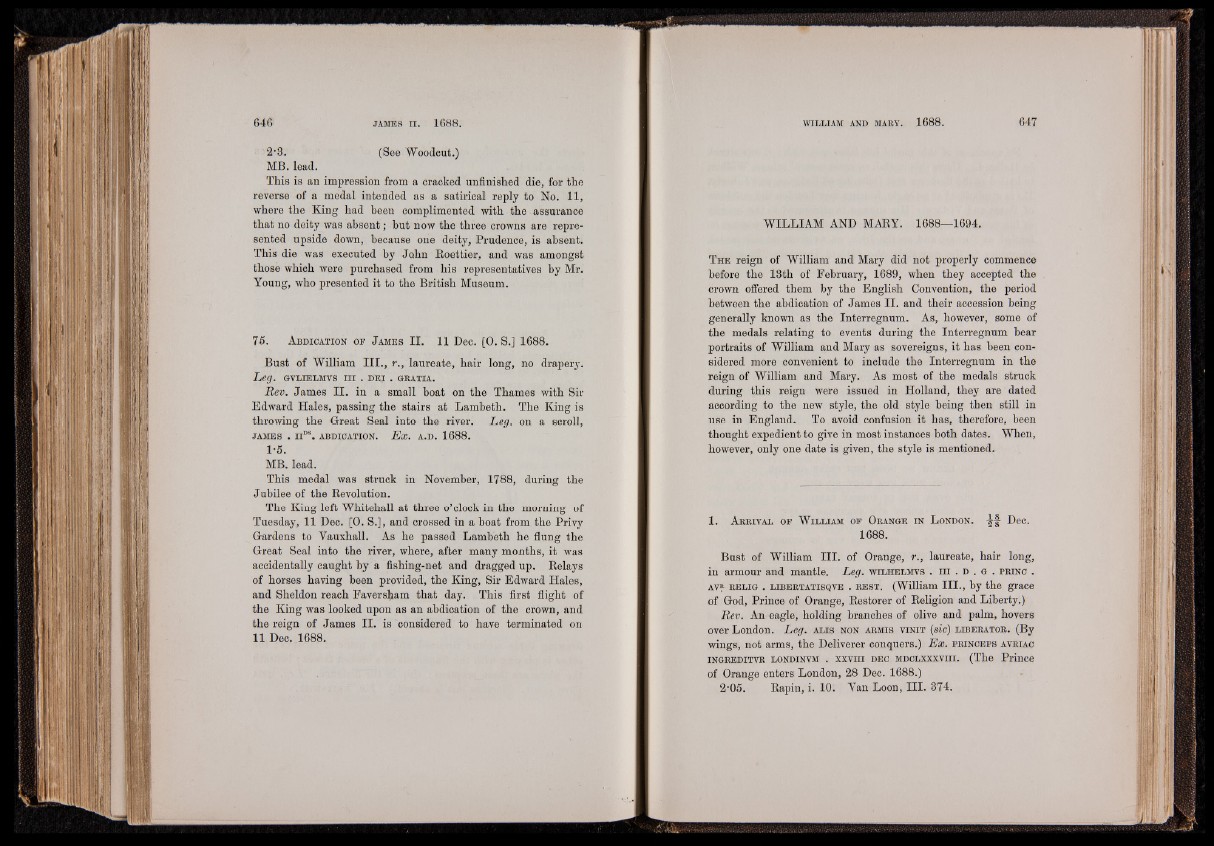
2'8. (See Woodcut.)
MB. lead.
This is an impression from a cracked unfinished die, for the
reverse of a medal intended as a satirical reply to No. 11,
where the King had been complimented with the assurance
that no deity was absent; but now the three crowns are represented
upside down, because one deity, Prudence, is absent.
This die was executed by John Roettier, and was amongst
those which were purchased from his representatives by Mr.
Young, who presented it to the British Museum.
75. A b d ic a t io n o f J am e s II. 11 Dec. [0. S.] 1688.
Bust of William II I., r., laureate, hair long, no drapery.
Leg. GVLIELMVS I II . DEI . GRATIA.
Rev. James II. in a small boat on the Thames with Sir
Edward Hales, passing the stairs at Lambeth. The King is
throwing the Great Seal into the river. Leg. on a scroll,
JAMES . I IDS. ABDICATION. Ex. A.D. 1688.
1-5.
MB. lead.
This medal was struck in November, 1788, during the
Jubilee of the Revolution.
The King left Whitehall at three o’clock in the morning of
Tuesday, 11 Dec. [0. S.], and crossed in a boat from the Privy
Gardens to Vauxhall. As he passed Lambeth he flung the
Great Seal into the river, where, after many months, it was
accidentally caught by a fishing-net and dragged up. Relays
of horses having been provided, the King, Sir Edward Hales,
and Sheldon reach Faversfyam that day. This first flight of
the King was looked upon as an abdication of the crown, and
the reign of James II. is considered to have terminated on
11 Dec. 1688.
WILLIAM AND MARY. 1688—1694.
The reign of William and Mary did not properly commence
before the 13th of February, 1689, when they accepted the
crown offered them by the English Convention, the period
between the abdication of James II. and their accession being
generally known as the Interregnum. As, however, some of
the medals relating to events during the Interregnum bear
portraits of William and Mary as sovereigns, it has been considered
more convenient to include the Interregnum in the
reign of William and Mary. As most of the medals struck
during this reign were issued in Holland, they are dated
according to the new style, the old style being then still in
use in England. To avoid confusion it has, therefore, been
thought expedient to give in most instances both dates. When,
however, only one date is given, the style is mentioned.
1 . A r r iv a l o f W il l ia m o f O ra ng e in L ondon . -Jf- Dec.
1688.
Bust of William I I I . of Orange, r., laureate, hair long,
in armour and mantle. Leg. w il h e lm v s . h i . d . g . p r in c .
av? r e l ig . l ib e r t a t is q v e . r e s t . (William I I I ., by the grace
of God, Prince of Orange, Restorer of Religion and Liberty.)
Rev. An eagle, holding branches of olive and palm, hovers
over London. Leg. a l is non a rm is v in it (sic) l ib e r a t o r . (By
wings, not arms, the Deliverer conquers.) Ex. p r in c e p s avriac
in g r e d it v r lo ndinvm . x x v iii d ec m d c l x x x v iii. (The Prince
of Orange enters London, 28 Dec. 1688.)
2-05. Rapin, i. 10. Yan Loon, III. 374.